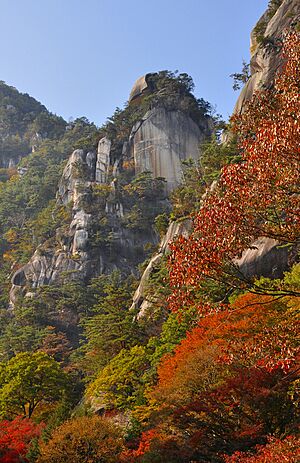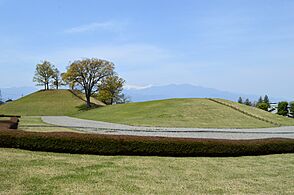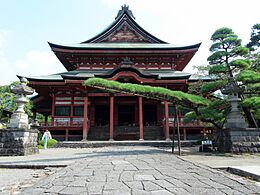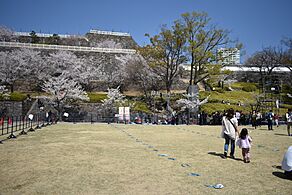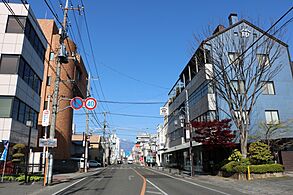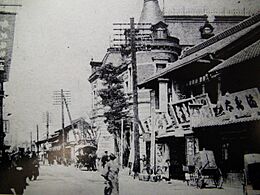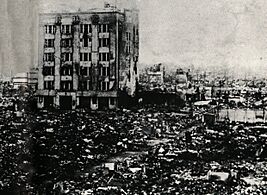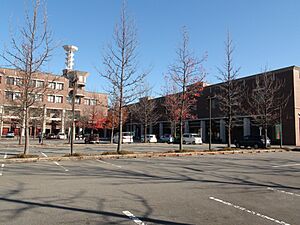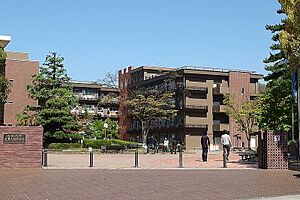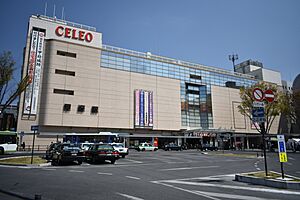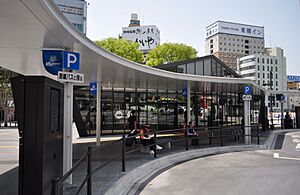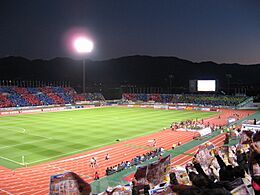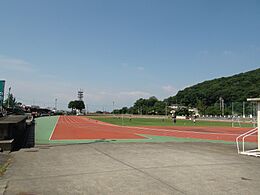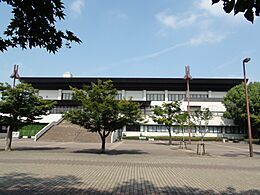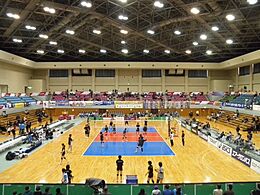Kōfu facts for kids
Quick facts for kids
Kōfu
甲府市
|
|||
|---|---|---|---|
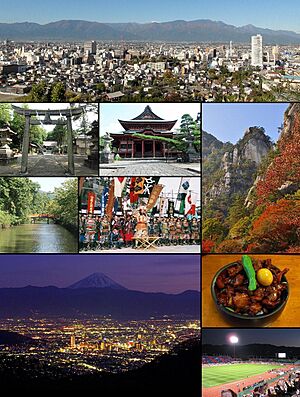
View from Sakaorimiya
Kai-Zenko-ji, Kakueno in autumn Moats of Kofu Castle, Takeda Shingen festival Night view of Kofu, Kofu motsu-ni stew Kose Sports Stadium |
|||
|
|||
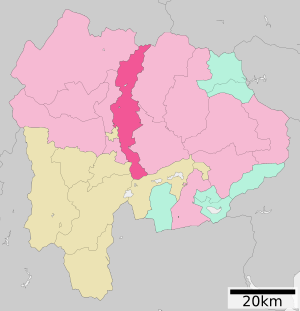 |
|||
| Country | Japan | ||
| Region | Chūbu (Tōkai) | ||
| Prefecture | Yamanashi | ||
| First official recorded | 100 BC | ||
| City Settled | July 1, 1889 | ||
| Area | |||
| • Total | 212.47 km2 (82.04 sq mi) | ||
| Population
(July 1, 2019)
|
|||
| • Total | 187,985 | ||
| • Density | 884.760/km2 (2,291.52/sq mi) | ||
| Time zone | UTC+9 (Japan Standard Time) | ||
| - Tree | Quercus | ||
| - Flower | Dianthus | ||
| - Bird | Common kingfisher | ||
| Phone number | 055-237-1161 | ||
| Address | 2-17-1 Aioi, Kōfu-shi, Yamanashi-ken400-8585 | ||
Kōfu (甲府市, Kōfu-shi) is the main city and capital of Yamanashi Prefecture in Japan. As of July 2019, about 187,985 people lived there. The city covers an area of about 212.41 square kilometers (82.01 sq mi).
Contents
About Kōfu City
What Kōfu Means
The name Kōfu means "capital of Kai Province". Long ago, during the Sengoku period (a time of war in Japan), Kōfu was known as the strong base of a powerful leader named Takeda Shingen.
City Views
Kōfu has many interesting sights. You can see old castles and modern city areas.
Geography and Climate
Where Kōfu is Located

Kōfu is in the middle of Yamanashi Prefecture, which is in central Honshu, Japan's largest island. The city is in a valley called the Kōfu Basin, about 250 to 300 meters (820 to 980 feet) above sea level. Mountains surround Kōfu on all sides. A large part of the city's northern area is within the Chichibu-Tama-Kai National Park. You can even see the famous Mount Fuji from Kōfu!
Kōfu's Weather
Kōfu has a warm, humid climate, but it's not as wet as coastal areas. This is because it's in a mountain valley that blocks some rain. Temperatures can change a lot. For example, in 2004, it reached 40°C (104°F), which is very hot for Japan. It can also get below 0°C (32°F) as early as October.
| Climate data for Kofu (1991−2020 normals, extremes 1894−present) | |||||||||||||
|---|---|---|---|---|---|---|---|---|---|---|---|---|---|
| Month | Jan | Feb | Mar | Apr | May | Jun | Jul | Aug | Sep | Oct | Nov | Dec | Year |
| Record high °C (°F) | 20.2 (68.4) |
25.4 (77.7) |
28.8 (83.8) |
33.1 (91.6) |
35.2 (95.4) |
38.3 (100.9) |
40.4 (104.7) |
40.7 (105.3) |
38.0 (100.4) |
33.8 (92.8) |
29.6 (85.3) |
24.9 (76.8) |
40.7 (105.3) |
| Mean daily maximum °C (°F) | 9.1 (48.4) |
10.9 (51.6) |
15.0 (59.0) |
20.7 (69.3) |
25.3 (77.5) |
27.8 (82.0) |
31.6 (88.9) |
33.0 (91.4) |
28.6 (83.5) |
22.5 (72.5) |
16.7 (62.1) |
11.4 (52.5) |
21.0 (69.8) |
| Daily mean °C (°F) | 3.1 (37.6) |
4.7 (40.5) |
8.6 (47.5) |
14.0 (57.2) |
18.8 (65.8) |
22.3 (72.1) |
26.0 (78.8) |
27.1 (80.8) |
23.2 (73.8) |
17.1 (62.8) |
10.8 (51.4) |
5.4 (41.7) |
15.1 (59.2) |
| Mean daily minimum °C (°F) | −2.1 (28.2) |
−0.7 (30.7) |
3.1 (37.6) |
8.4 (47.1) |
13.7 (56.7) |
18.3 (64.9) |
22.3 (72.1) |
23.3 (73.9) |
19.4 (66.9) |
13.0 (55.4) |
5.9 (42.6) |
0.3 (32.5) |
10.4 (50.7) |
| Record low °C (°F) | −19.5 (−3.1) |
−17.2 (1.0) |
−11.4 (11.5) |
−4.6 (23.7) |
−0.6 (30.9) |
5.4 (41.7) |
12.6 (54.7) |
13.2 (55.8) |
6.0 (42.8) |
−1.8 (28.8) |
−6.0 (21.2) |
−11.7 (10.9) |
−19.5 (−3.1) |
| Average precipitation mm (inches) | 42.7 (1.68) |
44.1 (1.74) |
86.2 (3.39) |
79.5 (3.13) |
85.4 (3.36) |
113.4 (4.46) |
148.8 (5.86) |
133.1 (5.24) |
178.7 (7.04) |
158.5 (6.24) |
52.7 (2.07) |
37.6 (1.48) |
1,160.7 (45.70) |
| Average snowfall cm (inches) | 9 (3.5) |
11 (4.3) |
1 (0.4) |
0 (0) |
0 (0) |
0 (0) |
0 (0) |
0 (0) |
0 (0) |
0 (0) |
0 (0) |
1 (0.4) |
23 (9.1) |
| Average precipitation days (≥ 0.5 mm) | 4.7 | 5.2 | 9.0 | 8.3 | 8.9 | 12.0 | 12.3 | 10.4 | 10.8 | 9.7 | 6.1 | 4.9 | 102.2 |
| Average relative humidity (%) | 55 | 52 | 55 | 57 | 62 | 69 | 72 | 70 | 71 | 71 | 67 | 60 | 64 |
| Mean monthly sunshine hours | 209.1 | 195.4 | 206.3 | 206.1 | 203.9 | 149.9 | 168.2 | 197.0 | 150.9 | 159.6 | 178.6 | 200.9 | 2,225.8 |
| Source: Japan Meteorological Agency | |||||||||||||
Nearby Cities and Towns
Kōfu is surrounded by several other cities and towns in Yamanashi Prefecture, and one town in Nagano Prefecture.
- Kawakami
- Chūō
- Fuefuki
- Fujikawaguchiko
- Hokuto
- Ichikawamisato
- Kai
- Minobu
- Shōwa
- Yamanashi
Population Changes
The number of people living in Kōfu has stayed mostly the same over the last 50 years.
| Historical population | ||
|---|---|---|
| Year | Pop. | ±% |
| 1940 | 102,419 | — |
| 1950 | 121,645 | +18.8% |
| 1960 | 160,963 | +32.3% |
| 1970 | 182,669 | +13.5% |
| 1980 | 199,262 | +9.1% |
| 1990 | 200,626 | +0.7% |
| 2000 | 196,154 | −2.2% |
| 2010 | 198,992 | +1.4% |
| 2020 | 189,591 | −4.7% |
History of Kōfu
Early Times
People have lived in the Kōfu area for a very long time. Archaeologists have found signs of human life from the Japanese Paleolithic period (Stone Age). People continued to live here through the Jōmon period, Yayoi period, and Kofun period.
During the Nara period, the main temple for Kai Province was built in Kōfu. This shows that Kōfu was an important center even then. Later, during the Heian period, a powerful family called the "Kai-Genji" ruled this area. They were known for their strong army that used horses.
Feudal Japan
By the Muromachi period, another powerful family, the Takeda clan, took control. They built a castle in what is now Kōfu. In 1519, under Takeda Nobutora, Kōfu was rebuilt as a castle town. It remained the capital for the Takeda clan, including under the famous leader Takeda Shingen.
During the Edo period, Kōfu was directly ruled by the Japanese government (the Tokugawa shogunate). Kōfu Castle was still the main administrative building.
Modern Kōfu
Kōfu officially became a city on July 1, 1889. In 1907, the city suffered a big flood due to heavy rain and too many trees being cut down. This caused a lot of damage to homes and roads.
During World War II, Kōfu was heavily bombed by American planes on July 6, 1945. Much of the city was destroyed.
Kōfu has continued to grow and change. On April 1, 2000, it was named a "special city" of Japan. In 2006, it grew bigger by including the town of Nakamichi and part of Kamikuishiki village. On April 1, 2019, Kōfu's status was upgraded to a "core city."
International Connections
Kōfu has "sister city" relationships with several cities around the world. This means they share culture and friendship.
| City | Country | State | Since |
|---|---|---|---|
| Des Moines | Iowa | August 16, 1958 | |
| Lodi | California | April 11, 1961 | |
| Pau | Nouvelle-Aquitaine | August 18, 1975 | |
| Chengdu | Sichuan | September 27, 1984 | |
| Cheongju | North Chungcheong | September 26, 2002 |
Kōfu also has a sister city in Japan:
| City | Prefecture | Region | Since |
|---|---|---|---|
| Yamatokōriyama | Kansai region | January 22, 1992 |
Economy and Industry

Kōfu is an important business and transport hub for central Yamanashi Prefecture. The city is known for its local industries. These include making food products like wine, textiles (fabrics), and beautiful crystalware.
Education in Kōfu
Kōfu has many schools and colleges for students of all ages.
Universities and Colleges
- Public Universities:
- University of Yamanashi
- Yamanashi Prefectural University
- Private Colleges:
- Yamanashi Eiwa College
- Yamanashi Gakuin Junior College
- Yamanashi Gakuin University
Schools for Younger Students
The city government runs 25 public elementary schools and 11 public junior high schools. There is also one national school that combines elementary and middle school. For private education, Kōfu has two elementary schools and three junior high schools. For older students, there are eight public high schools and five private high schools.
Getting Around Kōfu
Kōfu is well-connected by trains, buses, and roads.
Train Travel
You can travel by train using two main lines:
 East Japan Railway Company (JR East)
East Japan Railway Company (JR East)
Bus Services
- The main bus station is at Kōfu Station Bus Terminal.
Roads
- Expressway:
 Chūō Expressway
Chūō Expressway - National Routes: Several national routes pass through Kōfu, connecting it to other parts of Japan.
 National Route 20
National Route 20 National Route 52
National Route 52 National Route 140
National Route 140 National Route 137
National Route 137 National Route 358
National Route 358 National Route 411
National Route 411
Fun Things to See and Do
Historical Places to Visit
Kōfu has many historical sites where you can learn about its past.
- Kai Zenkō-ji (a famous temple)
- Kōfu Castle (an old castle ruin)
- Ōmaruyama Kofun (an ancient burial mound)
- Takeda Shrine (a shrine dedicated to Takeda Shingen)
- Tsutsujigasaki Castle (the former home of the Takeda clan)
- Yōgaiyama Castle (another historical castle)
Culture and Events
Shingen-ko Festival
The biggest festival in Kōfu is the Shingen-ko Festival (信玄公祭り, Shingen-ko Matsuri). It happens every year in April. This festival celebrates the life of the famous samurai leader Takeda Shingen. It lasts for three days and often features a famous Japanese celebrity playing Takeda Shingen. There are parades that go to and from the Takeda Shrine and Kōfu Castle. This festival is known for having the "largest gathering of samurai" in the world, with over 1,000 participants!
Sports Teams
Kōfu is home to two professional sports teams:
| Club | Sport | League | Home Venue | Started |
|---|---|---|---|---|
| Yamanashi Queenbees | Basketball | W.League | Kose Sports Park Gymnasium, Kōfu General Civic Center | 1968 |
| Ventforet Kofu | Soccer | J.League (J2) | JIT Recycle Ink Stadium | 1990 |
Famous People from Kōfu
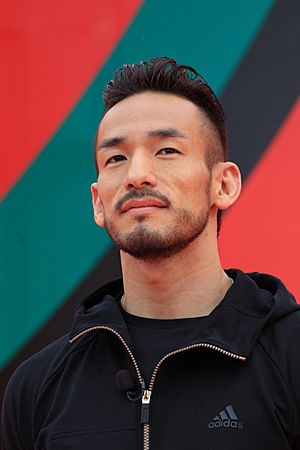
Many talented people come from Kōfu, including:
- Saiki Atsumi – lead singer of the rock band Band-Maid
- Banjō Ginga – a voice actor
- Ryūden Gōshi - a sumo wrestler
- Hidetoshi Nakata - a famous football (soccer) player who played for teams like Bolton Wanderers
- Naoko Takeuchi – a manga artist, who created the popular Sailor Moon comics.
Kōfu's Mayors
The mayor is the leader of the city government. The current mayor of Kōfu is Yūichi Higuchi, who has been in office since February 2015.
See also
 In Spanish: Kōfu (Yamanashi) para niños
In Spanish: Kōfu (Yamanashi) para niños











